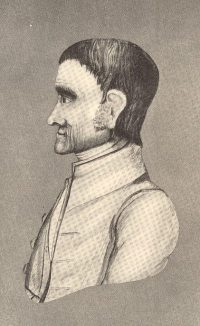John Woolman ? ? ?

In her Rancocas Edition of The Journal and Essays of John Woolman published in 1922 by The Macmillan Company, Amelia Mott Gummere, founder of the The John Woolman Memorial Association, wrote that the sepia drawing included in the 1908 sale of the estate of Pennsylvania Governor Samuel W. Pennypacker and the frontispiece of her book was almost certainly a drawing of John Woolman by his friend Robert Smith III. She notes that the technique is nearly identical to other sketches by Smith and that the medal of the British and Foreign Anti-slavery Association, founded in 1787 ( fifteen years after Woolman’s death) which appears in the lower left corner of the sketch proves that this is a “memory sketch” as were many of Smith’s portraits. She concludes by saying that a note by the governor on the reverse of the sketch is almost proof positive that the portrait is Woolman because the governor’s judgement “was seldom at fault.”
In 1942, author Janet Whitney, in her book John Woolman American Quaker published by Little, Brown and Company, disputes Gummere’s conclusion about the portrait. She notes that it was Robert Smith III’s grandfather, Judge Robert Smith, who was Woolman’s friend not his grandson. She also points out that the sketch is that of a man who appears to be very old: noting that John Woolman died at the age of 52. She concludes: the sketch is not Woolman. Her take: Governor Pennypacker guessed that the portrait might be Woolman because of the Anti-slavery medal incorporated in the drawing and then noted on the reverse, when he acquired the unsigned, unnamed sketch, “John Woolman ?” She concludes by saying her guess is the portrait is not Woolman , but his contemporary abolitionist Anthony Benezet.